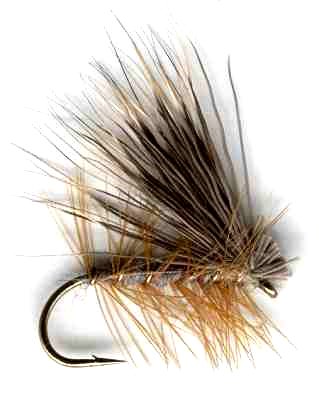Dark Wing Gray Elk Hair Caddis (Sedge) Fly
Fly-fishermen use artificial flies to imitate Adult Caddis flies, also known as sedge flies because their target fish, like trout, consider them lunch.

CADDIS FLY PATTERNS. Hook size 10 12 14 16 18 20 - $US each
Caddis flies belong to a group of insects called Trichoptera which is Ancient Greek for 'Hairy wings'. This identifying feature separates them from Moths and butterflies that have very small scales. Most Caddis flies stand with their wings folded over their backs like a ridge tent or roof. They have long feeling antennae that project straight out in front of their head. They do not have long tails like the upwinged Mayflies. In Britain there are 198 species of Caddis in Ireland and Britain, subdivided into eighteen families. These insects are one of the most important freshwater aquatic insect groups.
One of the distinctive characteristics of the Caddis Larvae is that for protection, many build portable tubular cases. It has a sticky substance on the outside which picks up the riverbed debris. This fact instantly camouflages the case. It is a very clever procedure. Caddis Larvae in this state are called cased caddis and many imitation fly fishing wet fly patterns have been created to copy this developmental state.

Like the Chrysalis of a moth or butterfly the caddis larva when fully grown changes into a pupa and is always concealed in a case that is usually attached to a rock or other large riverbed object. Using its jaws the Caddis Pupa cuts its way out of its case after a couple of weeks. It then swims up to the water surface ready to emerge as an Adult Caddis fly. Most caddis hatch on the water but some swim to the river bank. Both have to change quickly as they are easy prey when they are transforming. Some crawl up a nearby plant stem to give their wings time to dry. Others have to do this on the water surface but that is more risky. They then fly away. Many do not make it because they are sucked under the water by patrolling hungry trout.
Although adult caddis flies have small mouths they do not eat solid food but they can lap up nectar and water, Many species only live a couple of days. They can only survive whilst they have enough energy left. They must find a mate and the female has to lay her fertilised eggs before they collapse from hunger and die. Soon after emerging the males form a swarm. The females entre the column of flying caddis and find a mate. They couple and fall to the ground to complete the egg fertilisation. The unfortunate ones fall into the river and drown. Some females dip their tail onto the water and squirt the eggs out under the water surface. Other species females take a deep breath and crawl under the water to lay their sticky eggs onto stones. This is another very vulnerable time for the caddis fly and a good opportunity for trout to fill their bellies. There are many different types of caddis and all have long formal names but many of the common names are descriptive and reflect the diversity of colouring. Examples are Silver Sedge, Greentail, Mottled, Yellow Spotted, Speckled Peter, Sand fly and of course the Grey Caddis.

Fly Fisherman Al Troth designed the popular Elk Hair Caddis dry fly
CUSTOMER'S COMMENT
I find the Elk Hair
Caddis to be one of the most versatile trout fly patterns I have in my fly box.
If I spot daddy Longlegs (crane fly) having difficulties in the water surface
and do not have any imitations left, I have used a clipped Elk Hair with great
success. I like to keep a full range of hook sizes in my fly box so I am ready
to match the size of the insects hatching in front of me. If the hatch has just
started and there are more insects struggling in the water surface hatching than
are actually ontop of the surface drying their wings I quickly cut the hackle on
the bottom of a Elk Hair Caddis fly to make the bottom of the pattern float
lower in the water. Dave Morton, York, Yorkshire, England
LINKEDIN COMMENT
What flies work for Cutthroat Trout? - I am going to move back to fresh water in Canada , in western Alberta and eastern B.C. our native Cutthroat eat dry flies most of the time if then sun is out. Elk Hair Caddis, ants, and grass hoppers in the rivers, streams and Beaver Dams. In some of our mountain lakes we have very big fish to 12 lbs or more, small ants, and May flies if they are hatching, scuds fished deep also work well. Our native fish are beautiful, more so than the Yellowstones that were planted in many mountain lakes. By Mike Guinn
LINKEDIN COMMENT
What flies work for Cutthroat Trout? - Caddis patterns (e.g. Elk Hair Caddis, Stimulator, etc.) work very well out here in the West.
By Mark Greer



Fly Fishing books

